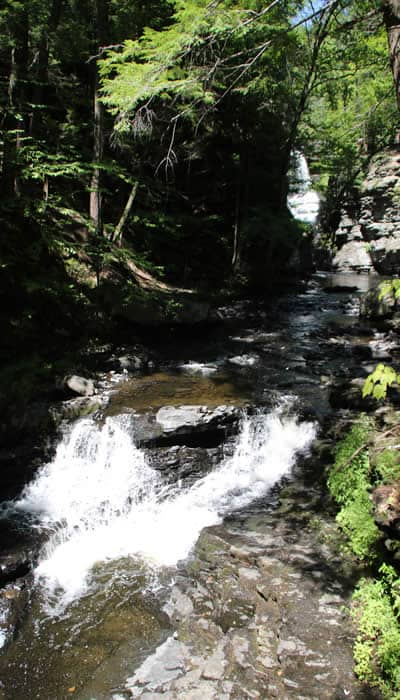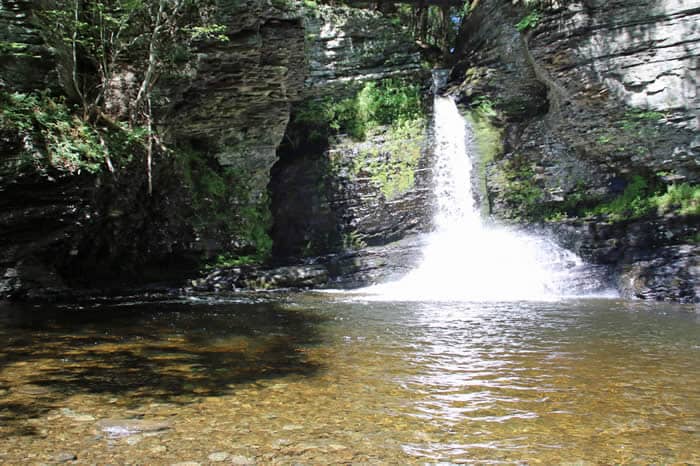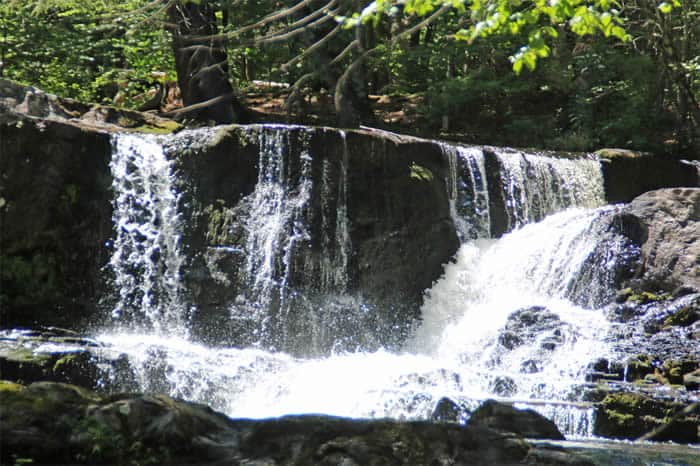
Childs Park

IF YOU GO
Where: Childs Park is in Delaware Water Gap National Recreation Area in northeastern Pennsylvania. Take Route 209 to the Dingmans Ferry stoplight. Take Route 739 west to Silver Lake Road, then left onto Childs Park Road. Ample parking.
GPS coordinates: 41-14.289N, 74-55.149W
Trail information: Easy to moderate walking on improved trails throughout. Handicap-accessible to the first waterfall, approximately 1/3 mile, one-way. Total is a 1.4-mile loop, with many stairs and boardwalks and elevation change of 144 feet.
KNOW BEFORE YOU GO:
- Working dogs only; no pets of any kind.
- No swimming, wading or rock jumping.
- Rangers patrol regularly.
- Ample parking with composting restrooms at trailhead.
- No trash receptacles – pack out what you pack in.
- National Park Service’s Childs Park information can be found here.

Visitors at Childs Park will find many waterfalls to admire.

Water, water everywhere at Childs Park
By Carol Hillestad

The falls pour steeply from one to the other, like water from a pitcher – the kind of falls you’ll want to see at different times, in different lights. It’s a nearly 150-foot drop from top to bottom: from Factory Falls at the top, where the stone remains of a short-lived woolen mill still stand, to the picnic pavilion at Fulmer Falls, to the narrow, rushing chute of Deer Leap Falls.
Manicured trails and stairs along the creek are clearly marked. There are new walkways, picnic spots, and interpretive signs along the way. For the first third of a mile, the trail is handicap-accessible, right to the edge of the first waterfall.
Childs is part of Delaware Water Gap National Recreation Area, and it protects Dingmans Creek, a tributary of the Delaware. The Delaware supplies water to a jaw-dropping 15 million people. So helping to keep the creek clean is important work!
George W. Childs, a well-to-do Philadelphia publisher, acquired the land in 1892 with the intention of opening it to the public as a park. Childs believed that open spaces and experiencing nature are important to all people. He died in 1894, before his dream could be fulfilled, and his widow donated the land to the Commonwealth in 1912. In 1983, it was transferred to the National Park Service.
Childs Park is so well loved that it suffers from overuse. On a late-summer visit, I asked two biologists, who were up to their knees in the creek as they monitored water levels and fish habitat, what they would like people to know about this beautiful place. In unison they called out, “Don’t trash it!”
The banks of the creek are packed hard by people going off-trail, causing a kind of natural pollution when hard rains send sediment and debris into the creek. “Sediment fence,” long sausages of mesh packed with straw, is in place to reduce the problem.
Visitors must stick to the paths and take out whatever they take in – because of abuse, there are no trash receptacles – so if you plan to picnic, plan to take leftovers and trash home with you. A small price to pay for time spent in this bewitching place!
Carol Hillestad of Cresco is a writer and hike leader for Get Outdoors Poconos, a free hike series administered by Brodhead Watershed Association.
Comments from other hikers:
Be the first to add your comment for this hike.